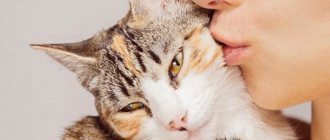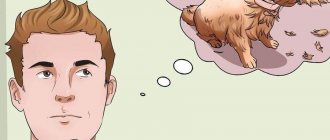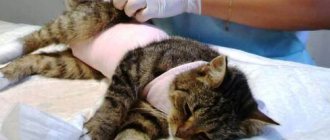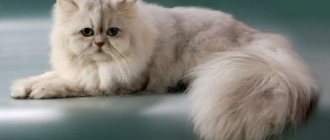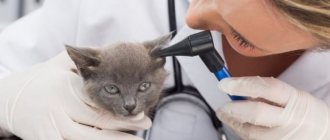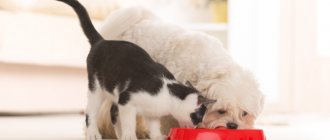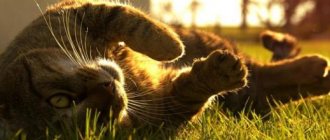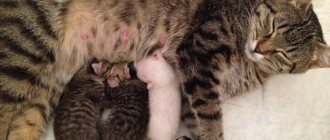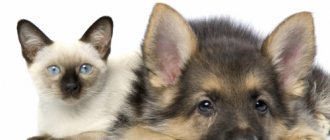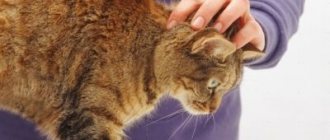If you don’t yet know what grooming is, then it is a procedural complex aimed at putting a cat’s skin and coat in order. During grooming, combining cosmetic and hygienic measures, long excess hair is trimmed. In cities, this can be done in specialized institutions, but pets are more comfortable in a homely, familiar environment.
Types of haircuts
Typically, cat care does not include a mandatory haircut. However, in some cases this procedure can be useful and even necessary. The following types are distinguished:
- Hygienic significantly simplifies the life of owners of long-haired breeds, relieving them of the need to comb their pet daily to avoid tangles. It is also carried out in cases where indelible substances are stuck to the fur (for example, paint, chewing gum), during the molting period, if the animal is susceptible to frequent formation of hair balls in the digestive system, as well as during the summer heat, when the cat’s fur is too warm and can lead to to overheating. In addition, it is recommended to trim old and sick cats if they are unable to care for themselves.
- Treatment is carried out on the recommendation of a veterinarian for infestation with lice and fleas, allergic dermatitis and hyperplasia of the sebaceous glands. Removing excess hair makes it easier to apply medications to the animal's skin. In some cases, complete shaving of the hair is indicated.
- Decorative or modeling is carried out at the request of the owner. The most common haircuts are “lion”, “dragon”, “puma” and “puss in boots”.
- Exhibition is done with the aim of giving the animal the appearance accepted for a given breed at exhibitions. Most often, this is done by qualified hairdressers in pet salons, but some owners learn to cut their pets' hair on their own. It is recommended to conduct it no later than six months before the exhibition.
Types of grooming
- Hygienic grooming. Its purpose is to ensure and maintain cleanliness and health of the cat’s coat, as well as to give the pet a well-groomed appearance.
Hygienic cat grooming includes the following procedures:
- Combing wool;
Bathing;
- Ear cleaning;
- Nail trimming;
- Hair trimming;
- If necessary, wash eyes and brush teeth.
- Exhibition grooming. The purpose of show grooming a cat is to bring its appearance into line with the standard that is the reference for a given breed. Exhibition grooming is only necessary for animals that regularly participate in shows, and in most cases is carried out by a professional groomer.
Cases when a haircut is undesirable
With all the advantages of a haircut, you should consider situations when it is better not to do it:
- The cat belongs to the short-haired breed.
- The animal lives or happens to be in cool places.
- There is often air conditioning in the room.
- The cat's fur does not need to be shortened.
- The kitten is still too small (under three months).
Also, experts do not recommend cutting the fur too short without good reason - its minimum length should be at least 3 mm.
Is it possible to cut cats?
Giving cats haircuts is not only possible, but also necessary, in certain cases. In most cases this is not necessary. Frequent haircuts are harmful to the animal.
Cats' fur is brushed daily, even if it is short. It is advisable to bathe and trim nails once a month. Particular attention should be paid to caring for the ears and eyes. The eyes are washed with cotton wool soaked in a tea solution if tear discharge is present. Ears also need to be cleaned regularly.
But the most difficult procedure is grooming the cat. It requires a set of special tools: massage brushes, tangle cutters, combs, furminators, hair dryers, slickers, wool rakes, regular and thinning scissors. All these tools are available to professional groomers.
If you want to cut the animal yourself, ordinary scissors, brushes and a clipper will suffice. Also prepare a table on which to place the animal and the iodine. It will need to be used in case of cuts. It is best if a family member helps you groom your cat. He will hold the animal if it begins to resist.
Haircut frequency
The optimal frequency of trimming depends on the breed of cat: they differ in the length, thickness and speed of hair growth.
Most often (up to four times a year) long-haired breeds need grooming: Persians, Ragdolls, Siberian and Angora cats, Maine Coons. Cats with medium-length hair, for example, British and Scottish Fold, need to be cut once or twice, preferably before the warm season.
Unscheduled haircuts are required if mats have formed on the fur. They cause severe discomfort to the animal, tightening the skin and preventing air exchange, which can create a favorable environment for the development of skin diseases.
Alternatively, you can trim the tangles as they appear, but this method has two significant disadvantages: firstly, there is a risk of accidentally injuring the cat’s skin, and secondly, it can cause damage to the cat’s appearance.
When does a cat need professional grooming?
The main feature of professional grooming is the emphasis on cutting the animal’s fur. If your cat needs a haircut, it is better to seek the help of a professional - take your pet to a grooming salon or call a groomer home. A professional groomer knows how to cut a cat's hair, causing him minimal discomfort.
Salon grooming is necessary for a cat in the following cases:
- There are tangles formed on the cat’s fur that you cannot sort out on your own for various reasons;
- A long-haired cat is hot in the summer - in this case it is better to reduce the length of the coat;
- You want to give your cat a fashionable haircut to prepare her for a show.
You should not overuse the haircut and resort to the services of a groomer too often, as hair trimming is stressful for the cat.
Mr. Cat recommends: varieties of model haircuts
Model haircuts are carried out with the aim of ennobling the animal’s exterior, emphasizing its individual characteristics or highlighting it through unusual, sometimes funny elements. When choosing a hairstyle, owners and groomers are guided by fashion trends and their own imagination. Such haircuts look especially impressive if the cat's undercoat is a different color than the top layer of fur.
The following varieties are distinguished:
- “Lion” is the most common type, when the entire body is shaved, except for the head, tail and paws.
- “Puma” or “Tulupchik” resembles “Lion”. The difference is that the front part of the body to the middle of the chest remains uncut - as if the cat is wearing a sheepskin coat made of its own fur.
- “Dragon” - hair on the head and paws, a strip along the spine is cut into teeth, and the tail is a herringbone or spiral.
- “Puss in Boots” is a version of “Lion” with intact fur on its paws.
In addition to ready-made haircut models, there are several basic elements that can be combined with each other to create new looks:
- "Tassel" on the tail.
- “Broom” - like “Brush”, only the hair at the end is cut straight.
- “Squirrel” - fluffy fur on the entire tail, except the very beginning, remains untouched.
- “Herringbone” - the fur on the tail is cut in several funny “brooms” one after another.
- “Knee socks” - paws are cut to the elbow.
- “Socks” are shorter than “socks”, below the elbow.
- Patterns - due to the difference in length, three-dimensional figures, letters and ornaments are cut on the wool.
Grooming cats at home: Types and features of cat hygiene
Many cat owners stoically endure periods when their pet sheds.
Wool throughout the house causes daily cleaning, and there is a need to constantly clean clothes after contact with your furry pet.
To get rid of such discomfort, there are grooming services that significantly reduce the shedding of the animal and make its appearance more tidy.
Prices for haircuts in the salon and at home
In the salon, haircuts are performed by an experienced groomer, whose work experience allows the procedure to be carried out faster and with better quality. In addition, he always has the necessary instruments and equipment at hand, and aggressive animals can be given anesthesia with veterinary permission.
The cost of such grooming starts from 500 rubles and increases depending on the type of haircut and the level of the salon. The average price of a full hygienic haircut is 2,000 rubles.
But despite all the advantages, the trip carries a lot of stress on the cat: transportation in transport, an unfamiliar place with a lot of new faces, smells and sounds can greatly frighten him. If your pet does not tolerate such situations well, it is better to call a groomer at home. Departure will cost an additional 200-300 rubles, but in a familiar home environment the cat will be much calmer. Many salons offer, for an additional fee, an assistant groomer who will secure the animal during the procedure.
When should you cut your cat's hair?
Cat grooming is done first when:
- the animal develops tangles;
- His fur is too thick and he is hot.
After the procedure, the cat, freed from excess fur, will feel much better.
Then a haircut is simply necessary for the health of the animal. But in fact, there are several types of grooming that are used in different situations.
- Hygienic. This is done to keep the cat's fur in order. Groomers trim it evenly and also trim off excess hair between the toes and on the pads of the paws. Hairs are also removed from the ears, and hair around the anus and genitals is processed.
- Exhibition . Animals are cut in a special way, emphasizing their advantages and hiding their shortcomings.
- Home.
This grooming is carried out not only by professionals, but also by the cat owners themselves and is a regular hair trimming. After it, combing and bathing your pets becomes much easier.
See also: How to make two cats friends?
Home haircut
Brave owners who decide to do grooming on their own, without the help of a professional, should take care to carefully organize the process.
Haircutting tools and accessories
First of all, you need to make sure that you have everything you need at hand during the procedure. Namely, you will need:
- Grooming table - instead, you can use a regular ironing board covered with a clean cloth.
- Latex gloves
- A special trimmer for cutting cats - the longer the coat and the thicker the undercoat, the more power the clipper will require.
- Scissors with rounded ends for cutting.
- Thinning scissors for final processing.
- Brush for combing wool before and after cutting.
- Cotton wool and disinfectant (such as hydrogen peroxide) in case of cuts.
Preparation
Before grooming, it is recommended to remove the collar, trim the cat’s claws, and give timid animals a sedative (for example, Stop-Stress, Fospasim, etc.). You should also take care of an assistant who will immobilize and calm the cat during the procedure.
The cat needs to be placed on its side, holding the front legs with one hand and the hind legs with the other. Do not hold it too tightly so as not to cause pain or discomfort to your pet.
Haircut process
You should start with the area along the spine, then proceed to the sides and stomach. The tail and paws are trimmed last. You should not remove hair below the elbows - the cat’s paws should remain in their “socks”.
The haircut can be carried out both in the direction of hair growth and against it. In this case, the skin must be slightly stretched to avoid the formation of folds - this can easily injure the animal. Be careful when treating uneven areas with sensitive skin: armpits, groin, nipples.
If you use a trimmer when cutting, you should choose knife No. 3, and after finishing, mill the wool with scissors.
If there are tangles in the wool, you need to use a special device to remove them - a tangle cutter. It can be replaced with a comb, fixing it between the skin and the tangle so as not to injure the animal with scissors.
It is forbidden:
- trim the hair on the head, ears and tip of the tail;
- trim whiskers and vibrissae;
- use tools not intended for grooming: ordinary scissors with sharp ends, trimmers for cutting people's hair.
After the haircut
After completing the procedure, you must carefully comb the trimmed hair out of the fur, and then wash the cat with shampoo. If it is clear that the animal is very stressed, it is not recommended to wash it immediately - just wipe it with a wet towel. To make the fur dry faster, you can dry it with warm air from a hairdryer - provided that the cat is not afraid of noise.
What does a set of grooming activities include?
The concept of “grooming” in zoology describes the instinctive behavior of animals to care for their bodies. Cats do this primarily not for beauty, but driven by the instinct of self-preservation - regular toileting eliminates the smell.
Today, grooming is a fashionable procedure that is carried out for pets in specialized salons. This set of procedures includes:
- detailed examination of the pet’s body to detect possible flaws;
- combing, washing and cutting;
- trimming and cleaning nails;
- cleaning the ears;
- hygienic treatment of the oral cavity and teeth, cleansing and removing tartar.
If you have some skills and the cat behaves quite calmly when it is bathed, grooming can be done at home.
When is the procedure necessary?
Cats are natural clean people, they always carefully groom themselves, they can lick their fur for hours, bringing it to perfect condition. But there are a number of cases when grooming must be carried out regularly without fail. And this need is dictated not by the owner’s desire to make his pet the most beautiful, but by hygiene requirements and the prevention of various diseases:
- the cat has access to the street and visits it often, has contact with other animals;
- severe shedding of the animal due to thick and long hair;
- detection of fleas or parasites in a pet;
- the animal has an eye or ear disease.
If the pet does not have any diseases, the frequency of hygiene procedures depends on the time of year. In the summer, especially if the animal is often outdoors, bathing and hair treatment is carried out more often than in the cold season.
Tools
To carry out grooming at home, you will need special tools:
- scissors;
- wool clipper;
- antiseptic drugs: hydrogen peroxide or iodine should always be on hand in case of skin cuts in order to treat the damage in time;
- table, any other surface on which the pet will be will do. It should be stable and comfortable, corresponding to the person’s height.
It is better and more convenient when grooming is carried out by several people. One deals directly with hygiene procedures, and the second holds the cat if it suddenly resists.
Recommendations for different cats
There are several subtleties based on the characteristics of the breeds.
When machine grooming cats with long, soft hair, you should go through each area several times, slowly, so that the clipper does not slip or get stuck.
Persian cats often react very aggressively to the procedure. To cope with the animal, you will need a skilled assistant.
If grooming is too stressful for your pet, it is better to avoid it.
British cats are short-haired and do not require hygienic grooming. Regular brushing provides them with proper care.
Angoras are cats with a very weak undercoat and require more frequent grooming than other breeds. Their coat is similar in structure to human hair, and its condition improves with regular grooming.
Maine Coons have a coat that grows very slowly. Among their owners, there are those who argue that these cats should not be cut at all, because the guard hairs may not recover after the procedure. Owners who decide to groom should be prepared for the fact that it will take a long time to grow the fur.
What is grooming
What is grooming? This is a cat grooming and additional procedures, the purpose of which is to improve the appearance, condition of the skin and coat of your pet. This result is obtained by ridding the cat of excess hair, removing dead hairs.
There are three types of grooming: hygienic, home and exhibition, otherwise called model grooming.
Hygienic grooming is the most practical option for this procedure. As the name implies, this type of grooming is used to ensure that the cat looks clean and tidy, does not leave fur on the carpets and furniture during the molting period and does not clog its stomach with it.
During this procedure, the cat's fur is trimmed evenly, the tips of the claws are removed using a special tool - a nail cutter, long tufts of hair on the paws are shortened, and the ears are tidied up.
Home grooming is the most budget-friendly, but also the simplest option: cat grooming, which is often mastered by cat owners themselves. It consists of shortening the pet's fur, which becomes much easier to care for.
Exhibition (model) grooming is a set of procedures that serve to emphasize the advantages and reduce the external disadvantages of animals that will participate in the exhibition.
Reasons for stopping hair growth
Sometimes owners experience a cessation or slowdown in fur growth after the procedure. This usually occurs due to alopecia - pathological hair loss, most often characteristic of cats of long-haired breeds. It manifests itself as redness and itching in certain areas of the skin.
Sometimes animals make the situation worse by scratching the damaged areas until they bleed.
Haircuts often provoke the development of this disease, but its causes lie in other factors:
- Unbalanced diet: lack of vitamins and minerals.
- Hormonal imbalance in the body.
- Side effects from taking medications.
- Allergy.
If you suspect alopecia, you should immediately contact your veterinarian.
How to calm a cat before a haircut
It is important that the cat is not nervous before the haircut, otherwise he will not only experience severe stress, but the procedure itself may not go as smoothly as we would like. Therefore, the most reasonable way is to resort to sedatives (cat bayun, stop stress), or, as a last resort, to anesthesia.
But under no circumstances should you give your cat medications without consulting a specialist - a groomer or veterinarian. Many professional groomers work without anesthesia. But first you need to agree on all the nuances.
Cat behavior
It is impossible to say with certainty that cats love grooming. And the point here is not so much in the fear and restlessness of animals, but in their upbringing and mood. If a kitten has been accustomed to basic hygiene since childhood, it will sit quietly while its fur is combed out, its ears are treated, and its teeth are brushed. A cat being groomed for the first time will become nervous.
Treatments in the salon begin with nail trimming, to which even a trained cat reacts differently. But when it comes to haircuts, few pets have a positive attitude towards it. Some individuals consider this humiliation, and therefore avoid the procedure for a long time. For them, such a procedure often results in stress and sometimes loss of appetite.
It is necessary to accustom a kitten to hygiene from the age of two to three months, gradually incorporating new types of procedures into home cat grooming. During grooming, a cat may scratch, bite, twist and try to escape. In some cases, after the procedure, its stress can develop into a problem such as the appearance of bald patches that will not heal. A cat may become nervous at the sound of a clipper or even a hair dryer.
Some pets may try to bite the groomer while he is bathing them. There is no need for wild haircuts, which can cause ridicule of your pet. Cats sense intonation very accurately; they understand not only a stern voice, but also the manner of conversation. Neither a haircut like a lion nor any other animal will give your pet confidence. They feel most confident with their own fur.
Step-by-step instructions for cutting hair at home
To groom a cat with clippers or scissors, follow these steps:
- turn your pet sideways, hold all paws;
- in case of strong aggression, wear a limiter collar;
- first you need to cut out all the tangles with scissors;
- then the scissors are put aside and the machine procedure begins;
- trim the sides and paws. Proceed to the stomach carefully so as not to damage the nipples and intimate area;
- the animal’s head is not cut, at most it is milled;
- You need to put a third of the hair on the tail, because cats usually start biting the bare tail and injure themselves.
Careful execution of operations is necessary so as not to injure the animal. If you didn’t manage to cut everything at once (the cat was very aggressive), then don’t be upset. You can stretch the procedure into several stages, the main thing is to wait for a peaceful state from your furry friend.
The final stage of cutting is washing and drying with a hairdryer.
Grooming of British cats
British shorthair cats! Their amazing plush coat with a soft shine and always neat and elegant appearance create a deceptive impression that this breed does not need any complex coat care and does not require a special diet. Actually this is not true. The famous plush coat has a complex two-level structure: a dense “stuffed” undercoat and guard hairs slightly protruding above it. It is this structure of the coat that creates a pearlescent sheen on blue and lilac colors, and gives shine to black and chocolate. This coat requires special care.
British Shorthairs are massive and heavy cats. To maintain massiveness, animals need a special diet with a high protein content (33-34%). Before the exhibition, even adult male cats can be put on food for kittens and pregnant cats for 2-3 weeks, which contains even more protein, but in this case vitamin supplements must be excluded from the diet to avoid allergies.
Brits need vitamins high in biotin, calcium and micronutrients in their daily diet. Vitamins or Gimpet give very good results. They contain all the necessary substances and are readily eaten by cats. If you want to emphasize the red color in an animal’s color, give vitamins with seaweed. Tortoiseshell, red, chocolate colors will become brighter, and lilac will acquire a warm pink tone. But it is better not to give seaweed supplements to blue and cream chinchillas and blue-cream cats: the color will darken. All cats need calcium, especially kittens and nursing mothers.
The plush coat of the British Shorthair is insidious. When licked, the fur enters the stomach and settles there in the form of insoluble lumps. This can lead to blockage of the intestinal passages. Fortunately, such a disaster is easy to deal with. From about 7-8 months, animals need to be accustomed to a special paste. It helps dissolve fur in the stomach and is pleasant to the taste.
From childhood, a kitten must be accustomed to everyday grooming, then in the future he will understand that examination of ears, eyes, teeth, and grooming is part of his life and will not resist examination at the veterinarian and judge’s table.
Cat Ear Care
We examine the cat's ears once every two weeks. Sinks must be clean, free of rashes, plaque, and unpleasant odors. Using a cotton swab, carefully clean the ear canal. In a healthy animal, sulfur is light and odorless. Often longer hairs called “tassels” grow at the end of the ear. They need to be removed. To do this, hold the tip of the ear with the fingers of one hand, and at the same time cut the hairs or pluck them with the other.
Eye care for British cats
British eyes generally do not require special care. In the morning, sometimes dark plaque accumulates in the corners of the eyes, which is removed with a solution of boric acid or simply with water applied to a soft cloth or paper napkins. Purulent discharge is unacceptable. If they appear in an animal, then consultation with a veterinarian is necessary.
eyes can be wiped with cotton swabs dipped in boiled water
Caring for cat's claws
Claws also require constant attention. They must be strong and not flake, and peeling at the base of the claw can be the beginning of a fungal disease. Inspection and trimming of claws is carried out once every 2-3 weeks. The claws on the front paws grow faster than those on the hind paws. Before cutting, look at the claw in the light: it contains a blood vessel that should not be touched. The tip of the claw, which begins to bend, should be cut off.
on the front legs
claw tip
and on the hind legs
By regularly trimming your nails, you will save yourself, your furniture, veterinarians and judges from too much stress. From the first day your kitten is in your home, think about a scratching post - this is one of the necessary items for a kitten to play with.
Let's talk about the fur of British cats
It requires care and attention. Britons are the only short-haired breed that loves brushing and stroking against hair growth. To care for the coat, you need the following tools: a metal, medium-frequency comb, preferably Teflon-coated, with rounded teeth that do not scratch the skin; massage brush, preferably a combination one - on one side there are natural bristles, on the other - metal teeth with an antistatic coating.
Grooming is easy. 1-2 times a week, using a metal brush and a massage brush, we comb the coat, first in the direction of hair growth, and then against it. This is a wonderful massage. Comb the fur first on the back, along the sides, and on the chest. The cheeks and neck are massaged towards the muzzle, i.e. against the fur. Cats love this procedure, they purr loudly and prop up their backs. After combing, excess fur is removed with wet hands or a special rubber mitten. A post-shed spray or protein conditioner will improve the structure and maintain the shine of the coat.
If an animal has dandruff, scratching is a cause for concern, and perhaps for contacting a veterinarian.
Once every 2-3 weeks you need to clean the fur coat using dry shampoo or grooming powder. The powder contains cleansing agents and silicone. The powder is applied to the fur, rubbed in with your hands, and then thoroughly combed out with a brush. This procedure will clean the wool of dust and grease, remove static electricity and add volume. Baby powders, even the most expensive ones, are not suitable, since they are based on rice starch, which, after licking, enters the stomach and can cause upset.
Brush the cat with a comb, first along the fur, then against it. This will remove dead hair - guard hairs and fluff. Pay attention to your back. As a rule, along the ridge, especially closer to the tail, there is more guard hair. It needs to be trimmed. To do this, hold the hair with the fingers of your left hand, and remove it with the fingers of your right hand. All procedures must be performed calmly so that the cat does not perceive them as punishment. It is better to remove guard hairs during estrus or molting, but no later than 3-4 weeks before the exhibition. On dark colors it is necessary to remove individual white hairs.
After trimming, you need to help the hairline recover. It is good to use a conditioner - a spray for removing hair after shedding and a conditioner - a spray with protein. These sprays will help in preparing the cat for the exhibition: they treat the animal’s fur daily for three weeks in a row. The conditioner is sprayed from a distance of 15-20 cm, lightly rubbed into the wool and allowed to dry.
All cats are washed, regardless of whether they participate in exhibitions or not, at least once every three months. For everyday washing, use high-quality shampoos for cats based on seaweed, medicinal herbs, lecithin, conditioner, and antistatic effect. Then your cat will always be well-groomed, with beautiful shiny fur, and you will always be ready for a show.
The cat is washed 5-6 days before the exhibition: if you want to improve the color, you can use tinted shampoos for cats, but for the first time it is better to wash the animal long before the exhibition in order to learn how to use them.
Features of washing cats of different colors
White cats are washed with white cat shampoo (whitening shampoo) 2-3 times. After secondary soaping, leave the shampoo for 2-3 minutes and then rinse off.
Chinchilla and silver marbled cats are also washed with shampoo for white animals, but when soaping again, do not keep it on the fur, but rinse it off immediately.
Blue, cream, lilac, blue-cream and lilac-cream colors are sometimes darkish. Then you can use shampoo for white cats (brightening shampoo). It will give the coat a lighter color.
Red, red-marbled and tortoiseshell cats are washed with red or bronze shampoo.
Chocolate cats are washed with bronze shampoo, adding a few drops of shampoo for black animals.
Black cats are washed with black shampoo.
It is better to use shampoos from well-known companies. There is no point in experimenting before an exhibition. Choose the right shampoo in advance.
The washing process is the same for all cats.
Water temperature 38-40 °C. Holding the cat by the shoulders or under the chest with one hand, wet the fur and apply shampoo to the withers, back, chest, belly and tail. Create a rich lather and rinse the coat thoroughly. Pay attention to the tail: in adult cats, sometimes it needs to be washed additionally. After the second soaping and rinsing, you can use a special fluffer (rinse aid). It is applied to the animal's fur and then washed off with water. After this, the cat needs to be wrapped in a towel and transferred to the table. Dry it, changing the towel 2-3 times. Then apply a little dry shampoo or grooming powder to the damp coat and massage; When all the powder has been removed, spray the wool a little with Coat Gloss spray and dry it with a hairdryer. When drying, lift the coat with a metal massage brush. You need to dry it completely, then the wool will be voluminous longer.
At the exhibition, you need to lightly powder the back and cheeks of the animal, lift the fur with a brush with natural bristles, let it dry, and then lightly moisten it with an antistatic agent. After this, trim the fur on the back with your hands.
Remember that grooming is an art and must be mastered at home. Both you and your pet must learn to endure all procedures patiently and calmly. Even if your pet doesn’t immediately like everything you do to him and he uses his claws and teeth, you shouldn’t punish him for this. On the contrary, caress him, calm him down, treat him with a treat, distract him with a toy.
And remember: all your efforts will return to you in the form of awards and cups.
Good luck to you and your pets!
Article by Elena Prokhorova, Friend Magazine 6-7, 1998
Photos by Viktor Olifirov
What should you consider before grooming your cat?
- Grooming in any case is stressful for the cat, so you should not carry out grooming if there is no need for it in the form of health problems, falling fur or an upcoming exhibition. If there is still a need, breeders should consult a veterinarian or groomer about the possibility of using sedatives, or even anesthesia (sedation). Sedatives simply make the animal more docile, remove nervousness and allow the groomer to do his job. In some cases, their use is necessary, but not all groomers work with anesthesia. In any case, it is best to entrust this procedure to a veterinarian.
- You should not try to groom yourself. The main reason for this is that most owners do not have the necessary tools - ordinary scissors or a machine for cutting human hair will not work here. In addition, amateur grooming can physically harm the animal.
The most “violent” ones should be calmed down with anesthesia during grooming
- The best option would be to groom your cat at home, especially if she is nervous and does not like this procedure. The home environment will have a positive effect on the animal's calmness. In addition, it is convenient and less time-consuming (no need to waste time on transportation).
- Some cats change the structure and color of their coat after grooming. For example, it may become thinner and darker.
- In some cases, the pet's fur does not grow back to its previous length after grooming, or regrowth takes a very long time. These features are individual and depend on the general health of the animal, its breed and age.
- It is strongly recommended not to trim the cat's head, ears, whiskers and eyebrows. Also, do not completely cut off the hair from the tail.
- Since most cats react violently to grooming, their nails should be trimmed first to prevent wounds and scratches for the owner, the groomer and the pet itself.
Grooming for a cat is always stressful
How to understand that a cat needs grooming?
As a rule, there are several factors that indicate the need for a groomer's intervention:
If a cat has a large number of mats, this leads to skin irritation and diaper rash.
If the problem is neglected, the animal may develop pockets of inflammation and flea “nests.”
Lumps, pellets, and matted fur are very difficult to comb - they bring discomfort to the animal’s life.
Under no circumstances should mats be cut off with scissors, as they can easily hurt your pet’s skin.
You should also not wash a cat with this problem - under the tangles, the skin dries slowly, and soaked skin easily becomes inflamed.
The most correct choice in this case is grooming.
- Cat health problems;
In cases where a cat has skin problems, grooming is necessary to trim the hair in the right places and make it easier to access the skin and process it more effectively.
Haircut is necessary for dermatitis, fleas, ear mites and increased secretion of the sebaceous glands (hyperplasia).
Grooming is also strongly recommended for cats who are unable to care for themselves due to illness or old age.
Maine Coon cats are especially fluffy
- Excessive hair loss;
If your pet sheds too much and often, grooming will significantly reduce the scattering of hair in the house and on clothes.
Typically, grooming is ordered by breeders with small children.
The absence of a large amount of cat hair in the house prevents the child from swallowing it and significantly reduces the likelihood of allergic reactions.
Cat grooming: features of the procedure
join the discussion
Share with your friends
Animal care professionals know what grooming is. However, recently this term has become vague, if not completely unclear. Some people, for example, believe that this is what they call grooming pets. Let's look at the nuances of the term, the features of the procedure, and find out who needs it, as well as how it affects the behavior of the animal.
